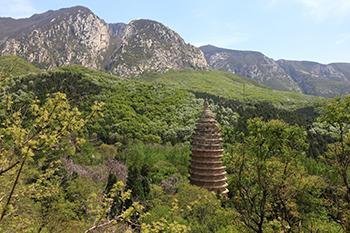
Site visited April 2017. The historic monuments of the city of Dengfeng was a pleasant experience. There were absolutely the smallest amount of visitors among the sites that I have visited in China. The places were calm and quiet and some of them are surrounded by beautiful nature. I visited five of the eight inscribed properties.
First of all I must tell that in this review I'm not going to mention anything about visiting the Shaolin Temple. Actually I had heard nothing but bad things about it being a major tourist trap. So I deliberately left that off from my itinerary. I was curious to see what other things there are in this WHS.
Despite of being named after the city of Dengfeng, this inscription is all about Mount Songshan and the monuments connected to and located around it. Mount Songshan is one of the most sacred Taoist mountains of China. The city of Dengfeng at the foot of Mount Songshan is a spiritual center where the most important temples and religious institutions are located.
I would say sarcastically that it is quite difficult to get to the city of Dengfeng. Not because of bad transport options, actually those are very good, but because everyone assume that you want to go not to Dengfeng but to Shaolin Temple. All the people in Luoyang is trying to push you to Shaolin, even the ticket salesman at the bus station counter. So after some worthless efforts to buy a bus ticket to Dengfeng I just walked directly to bus platforms and asked some people a bus to Dengfeng. Also there someone tried to direct me to a Shaolin bus. After all the hassle I found my way to a Dengfeng bus. The bus trip from Luoyang took almost two hours, half of which goes to traffic jams in Luoyang.
Dengfeng, one of the early capitals of China, is nowadays a sleepy provincial town. From the bus station it is three kilometres to the gate and ticket office of Songyang Scenic Park. You can take a taxi to the gate and after that either walk uphill or pay a small price to the cars that offer rides to visitors. The quite modest ticket price of 80 RMB includes a nice and informative booklet with a map of area and descriptions of each site. Songyang Academy and Zhongyue Temple require additional 30 RMB entrance fee.
It is worth mentioning that the slopes of Mount Songshan are full of interesting temples and other religious places, not just these eight selected World Heritage Sites. It would have been nice to hike also to the higher parts of the mountain but I didn’t have time for that. Mount Songshan is also UNESCO Global Geopark.
The Songye Temple Pagoda was the nicest site among those I visited. It is absolutely beautiful building surrounded by lushly vegetated mountain nature. This pagoda is 37 metres high and it was built AD 523. It is one of the oldest pagodas in China and oldest known Chinese brick pagoda. It is known as "the first Chinese tower". For those who love photography it is really worth climbing to the hill outside of temple because there are beautiful and photogenic views to green slopes of Mount Songshan and the top of pagoda.
Songyang Academy of Classical Learning is nearest site to the park gate and the city centre of Dengfeng. This institution of higher learning was one of the four great academies in ancient China. The prominent feature of Songyang Academy is its steles. The most important stele is so called Tang Tablet which is important in Chinese handwriting history. There are also lot of other steles around the temple courtyard. Inside the temple area are also two 4500 years old cypress trees that are said to be oldest trees in China.
While the other places I visited are easy to visit going downhill starting from Songye Temple, the Huishan Temple is to the other direction towards the Shaolin Temple. It was a long detour and although it is considered one of the four main temples of Mount Songshan I didn't find it very interesting. There were least visitors among the Dengfeng sites. I was maybe one of three visitors at the temple.
The building of Qimu Que Gates was closed at the time of my visit. Basically it includes Han Que gates built in AD 123. There are only 34 ancient stone Han Que gates in China, three of which are at Mount Songshan.
The huge Zhongyue Temple is maybe the centerpiece of this WHS along with the Shaolin Temple. Taishi Que Gates built in AD 118 in front of Zhongyue Temple are one of three ancient Han Que gates of Mount Songshan. Zhongyue Temple has been originally built on the site of Taishi Shrine. Since then the temple was rebuilt many times. During the Qing Dynasty it was restored according to the Forbidden City in Beijing and it is also called the ”Small Forbidden City”. There are 39 buildings on the multiple courtyards and hundreds of ancient cypress trees. The main building of the temple, the Junji Hall, is the largest building of the five sacred mountains of China.
With my review I don't mean to say that don't go to Shaolin Temple at all but to encourage people to check out what other things there are to see on this WHS. I found the historic monuments of Dengfeng worth visiting, especially Songye Temple Pagoda and Zhongyue Temple, and also the Gaocheng Observatory should be of interest. Moreover, those sites are quite peaceful places with few tourists which is very unusual in China. Together with the beautiful slopes of Mount Songshan they form very nice ensemble.
More on
Comments
No comments yet.
